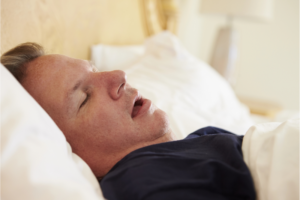Is a good night’s rest constantly avoiding you? Your struggles may be caused by a sleep-related respiratory disorder. These conditions interfere with your breathing patterns during sleep, disrupting the vital restorative sleep your body needs. Understanding these disorders is the first step toward improved sleep and overall well-being.
Don’t underestimate the power of restful sleep. It’s essential for physical repair, immune function, and mental clarity. By understanding the types of sleep-related respiratory disorders, you can empower yourself to take control and regain restful nights.
Obstructive Sleep Apnea (OSA)
What is it?
Obstructive sleep apnea is the most common type of sleep-related respiratory disorder. It occurs when the muscles in your throat relax too much during sleep, temporarily blocking the airway.
How common is OSA?
It affects millions of Americans and often goes undiagnosed. If you suspect OSA, don’t ignore it—early diagnosis is important.
What causes it?
Risk factors include obesity, enlarged tonsils or adenoids, and certain facial structures. Additionally, men, older adults, and those with a family history of OSA are at higher risk.
Warning signs
Loud snoring, gasping for air, excessive daytime sleepiness, and morning headaches are all hallmark signs. If your partner notices pauses in your breathing during sleep, that’s another important red flag.
How is it treated?
Lifestyle changes like weight loss and avoiding alcohol before bed can be helpful. Continuous positive airway pressure (CPAP) therapy is the gold-standard treatment, delivering a gentle stream of air to keep your airway open during sleep. Oral appliances are also an option for some, and in specific cases, surgery may be considered.
Don’t downplay the seriousness of OSA. It’s not just about snoring; left untreated, OSA can increase your risk for serious health conditions like high blood pressure, heart disease, stroke, and diabetes. Seeking a proper diagnosis and adhering to treatment is essential for safeguarding your well-being.
Central Sleep Apnea (CSA)
What is it?
In central sleep apnea, the brain temporarily stops sending signals to the muscles that control breathing. This differs from OSA, where the airway itself is physically blocked. Essentially, in CSA your brain momentarily ‘forgets’ to tell your body to breathe.
What causes it?
CSA is often linked to underlying medical conditions like heart failure, stroke, brain injuries, or the use of certain medications (particularly opioid pain relievers).
Warning signs
Frequent awakenings during the night, gasping for breath, insomnia, and irregular breathing patterns (Cheyne-Stokes respiration, which involves cycles of deep and shallow breathing followed by pauses) are common. Unlike OSA, loud snoring may not be a prominent symptom of CSA.
How is it treated?
The most important step is addressing the underlying medical problem causing CSA. Once that’s managed, specific therapies may be recommended. CPAP is often helpful, but specialized forms like BiPAP or ASV (adaptive servo-ventilation) may be even more effective in specific cases. These therapies provide a gentle air flow and offer a backup rate of breath intervals to ensure you keep breathing steadily.
Understanding why CSA is different is important. With CSA, the problem isn’t with your throat muscles; it’s with the signal from your brain. This distinction is key for your asthma doctor in Midtown, New York, to determine the most appropriate diagnosis and treatment plan for your needs.
Sleep-Related Hypoventilation Disorders
What is it?
This group of disorders is characterized by inadequate breathing during sleep, leading to increased carbon dioxide levels in the blood. This means your body isn’t getting enough oxygen and isn’t expelling carbon dioxide effectively, creating an imbalance that can have serious health consequences.
Focus on Obesity Hypoventilation Syndrome (OHS)
OHS occurs when excess weight puts pressure on the chest and lungs, interfering with breathing. Obesity restricts the ability of the lungs to expand fully, making it harder to breathe in deeply and exhale completely.
Symptoms
Daytime sleepiness, shortness of breath, morning headaches, and swelling in the legs are common signs of OHS. Individuals with OHS may also struggle with concentration problems and mood changes due to a lack of quality sleep and insufficient oxygen.
How is it treated?
Weight loss is often a critical component of managing OHS. Even a modest reduction in weight can significantly improve breathing. CPAP or BiPAP therapy is also highly effective. These therapies work by delivering pressurized air to help keep the airway open and support proper breathing patterns, reducing carbon dioxide levels and increasing oxygenation.
It’s important to understand that sleep-related hypoventilation disorders can occur in people of all sizes. However, if you’re carrying extra weight and experiencing sleep problems, it’s definitely a condition to discuss with your asthma doctor in Midtown, New York. Addressing both your weight and any underlying breathing disorder is crucial to restore your health and quality of life.
Chronic Obstructive Pulmonary Disease (COPD)
What is it?
COPD is a progressive lung disease that makes breathing difficult. It encompasses conditions like emphysema (damage to the air sacs in the lungs) and chronic bronchitis (long-term inflammation of the airways). COPD develops over time, with symptoms often worsening as the disease progresses.
How does COPD impact sleep?
People with COPD often experience a vicious cycle of breathing problems and sleep disruption. Shortness of breath, coughing, wheezing, and increased mucus production can all make it difficult to fall asleep and stay asleep through the night. This fragmented sleep leads to daytime fatigue and further worsens overall health and quality of life.
Treatment
While there’s no cure for COPD, treatment is focused on managing the symptoms, slowing disease progression, and improving your ability to breathe. This may involve:
- Medications: Bronchodilators (inhalers) to open the airways, and sometimes, inhaled or oral steroids to reduce inflammation.
- Pulmonary rehabilitation: A tailored program of exercise, education, and breathing techniques to strengthen your respiratory system and improve your ability to cope.
- Oxygen therapy: If your oxygen levels are low, supplemental oxygen may be prescribed.
- Non-invasive ventilation: In some cases, using a machine like CPAP or BiPAP at night can support breathing and improve sleep quality.
- Surgery: For a small number of patients, surgery to reduce lung volume or lung transplantation may be considered.
Managing COPD goes hand-in-hand with improving your sleep. Talk to your asthma doctor in Midtown, New York, about optimizing your treatment plan to minimize nighttime disruptions and allow you to get the rest you need.
Narcolepsy
What is it?
Narcolepsy is a neurological disorder marked by overwhelming daytime sleepiness, even after a full night’s sleep. This sleepiness isn’t simply feeling tired; people with narcolepsy may experience sudden, irresistible “sleep attacks” that can occur during any activity. Other symptoms can include cataplexy (sudden loss of muscle tone triggered by strong emotions), sleep paralysis, and vivid hallucinations when falling asleep or waking up.
Respiratory connection
While not a classic symptom for everyone, some individuals with narcolepsy may experience breathing difficulties during sleep. This can include periods of disrupted breathing or even central sleep apnea.
Treatment
While there’s no cure for narcolepsy, treatment can significantly improve symptoms and quality of life. This includes:
- Medications: Stimulants to promote wakefulness, and other medications to address specific symptoms like cataplexy.
- Lifestyle changes: Maintaining a regular sleep schedule, avoiding alcohol and caffeine before bed, and incorporating scheduled naps throughout the day can be very helpful.
- Support and counseling: Adapting to the challenges of narcolepsy takes time. Finding support groups and mental health counseling can be beneficial for learning coping strategies and managing the emotional impact of this disorder.
If you suspect that excessive daytime sleepiness or other symptoms could be related to narcolepsy, it’s important to see a sleep specialist. A proper diagnosis opens the door to treatment options to help you live a fuller and more engaged life.
The Importance of Getting Help
Sleep-related respiratory disorders can seriously impact your health and well-being. If you suspect you may be experiencing one of these conditions, it’s important to seek help. Early diagnosis and treatment will protect your sleep quality, improve your energy levels, and enhance your overall health.
In addition to the immediate benefits of improved sleep, addressing sleep-related respiratory disorders can also help reduce your risk of developing other chronic health conditions. These conditions can include heart disease, stroke, high blood pressure, diabetes, and even depression.
Left untreated, sleep apnea can also increase your risk of accidents and injuries. This is because chronic sleep deprivation can impair your judgment, coordination, and reaction time. By seeking help for a sleep-related respiratory disorder, you can improve your sleep quality and reduce your risk of serious health complications. Don’t hesitate to talk to your asthma doctor in Midtown, New York, if you experience symptoms such as loud snoring, gasping for air during sleep, morning headaches, or excessive daytime tiredness.
Where to Find Relief
If you are searching for an “asthma doctor near me” consider the experts at Kamelhar-Teller Pulmonology. They specialize in diagnosing and treating the full spectrum of sleep-related respiratory disorders. Their personalized treatment plans can help you finally achieve the restful nights you deserve.
Don’t delay, contact Kamelhar-Teller Pulmonology today and take the first step toward a healthier, more well-rested you!



